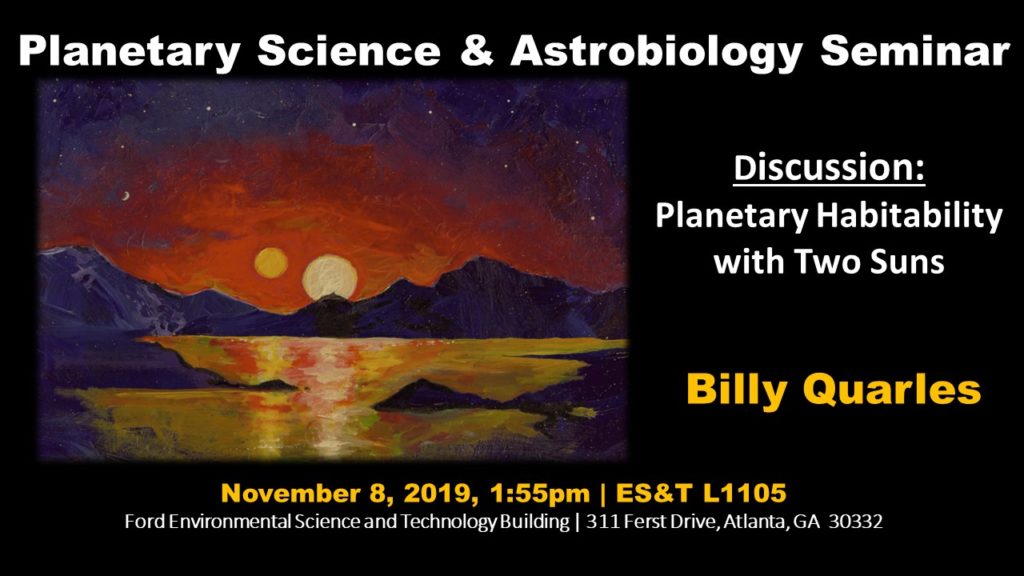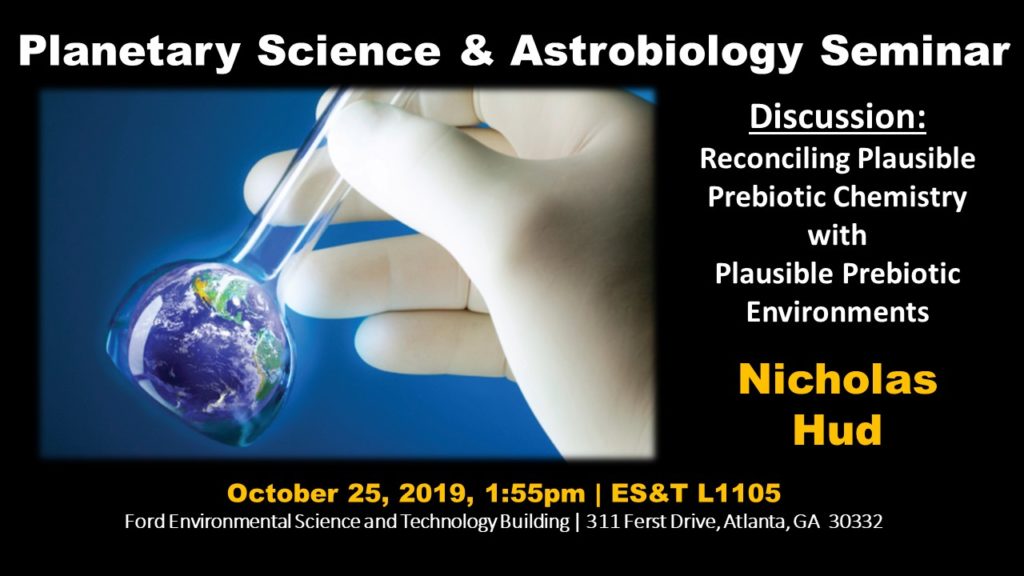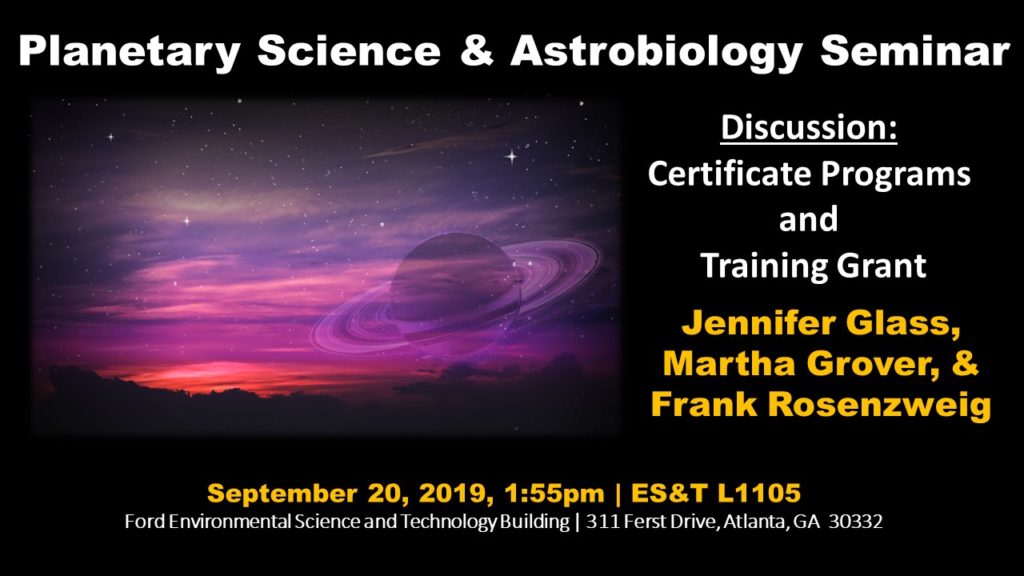
11/08/2019: “Planetary Habitability with Two Suns” Billy Quarles (GT)

11/08/2019: “Planetary Habitability with Two Suns” Billy Quarles (GT)

10/252019: “Reconciling Plausible Prebiotic Chemistry with Plausible Prebiotic Environments” Nicholas Hud (GT)

10/18/2019: “Big Picture from Small Bodies and Small Stats” Kynan Hughson and Phillip Szot (GT)

10/04/2019: “Ocean World Habitability and Exploration” Chase Chivers and Chinmayee Govinda Raj (GT)

09/27/2019: “Biosphere Evolution on Earth and Elsewhere” Anthony Burnetti (GT)

09/20/2019: “Certificate Programs and Training Grant” Jennifer Glass, Martha Grover, & Frank Rosenzweig (GT)

09/13/2019: “Chemical Origins of Life” David Fialho and Aaron Mckee (GT)

09/06/2019: “What is Astrobiology” Elizabeth Spiers and Micah Schaible (GT)
Translation is one of the most ancient and essential biological processes. An important step in the process is aminoacylation, by which tRNA are loaded with the amino acid cognate to their anticodon specificity. This process is carried out in all life by two unrelated groups of proteins, Class I and Class II aminoacyl-tRNA synthetases (aaRSs), each class containing protein families with specificity for 10 of the 20 canonical amino acids. As all aaRS families are present across all 3 Domains of life, it has been inferred that the lineage containing LUCA inherited a full “modern” collection of aaRS. Therefore, these protein families must have diversified from a common ancestor pre-LUCA. While clearly homologous, extensive structural and sequence divergence within each family makes alignment and phylogenetic reconstruction extremely difficult. Previous phylogenetic reconstructions of pre-LUCA aaRS divergences have therefore only used small highly conserved regions of the proteins associated with the catalytic aminoacylation domain, leading to poorly resolved histories due to an insufficient number of informative sites. Here I present an improved alignment of Class I aaRS proteins, that recovers a much greater number of informative sites, and produces a fully resolved, robust phylogeny. Improved alignment techniques, including structure-based alignments, still consistently mis-align regions of these proteins. Therefore, a careful, site-by-site manually curated alignment was performed, with reference to structural and functional studies in the literature. The resulting phylogeny is distinctly ladderized, permitting a rooting of protein family divergences based on parsimony models for insertion and deletions. Ancestral sequence reconstruction of the root shows that all 20 amino acids were very likely already being incorporated at conserved sites within the ancestor, requiring a “modern” genetic code to predate the origin of cognate aaRS proteins. This result is only possible if the protein-based aaRS system was predated by an earlier aminoacylation coding system, implicating such a process being part of the RNA world. Additionally, we show that the best fitting evolutionary models for these ancient protein divergences resemble those empirically determined from modern proteins, and that our observed phylogeny is unlikely biased by wrongly assuming that an earlier genetic code operated by the same general substitution frequencies. This further supports that not only the amino acid alphabet, but the structure of the genetic code itself may have been similarly modern at this time. Finally, we make the surprising observation that bacterial leucyl-tRNA synthetase underwent a major recombination event early in its history, inserting its proofreading domain to a different region of the protein. Misalignments resulting from this recombination may have further confounded previous attempts at reconstructing the history of this protein family.
The search for life beyond Earth is a major focus of space exploration, both robotic and human. Informed by the molecular biology revolution, exploration of extreme environments, from Earth, to icy moons, and exoplanets, are dramatically transforming our view of life in the universe. We now know that Mars was once habitable and may support life today. We are developing the Search for Extra-Terrestrial Genomes (SETG) to search for life on Mars ancestrally related to us, possibly shared by ancient impact events that transported a billion tons of rock between our worlds. Beyond Mars, we can now seriously consider missions to search for life at Enceladus, or Europa, although it will require transformational mission capabilities including a revolution in autonomy. More broadly, we now have the foundation to understand the limits of our own adaptation to space, and to augment those limits through innovative engineering, both biologically inspired, and biology-based. Building the tools required for a robotic and human future in space, on Mars, and beyond, we can simultaneously advance human health and sustainability on Earth.
Biography: Christopher E. Carr is a Research Scientist in the Department of Earth, Atmospheric and Planetary Sciences at MIT and a Research Fellow in the Massachusetts General Hospital Department of Molecular Biology. After completing dual S.B. degrees in Aero/Astro and Electrical Engineering from MIT, Dr. Carr worked on the Mars Sample Return mission at the Jet Propulsion Laboratory. As an NSF Graduate Research Fellow, Dr. Carr applied bioengineering principles to human adaptation to space, the bioenergetics of movement, and improved space-suit design. He currently serves as the Science PI for the SETG life detection instrument, also relevant to astronaut health, space biotechnology, and field research. He is broadly interested in searching for and expanding the presence of life beyond Earth.
“The Georgia Department of Economic Development and Georgia Tech Center for Space Technology & Research are hosting a one-day symposium at the Georgia Tech Global Learning Center in Atlanta, GA. The symposium is planning a combination of technical presentations, panel discussions and guest speakers to highlight recent innovations in space science and technology.”
Avi has a wide range of research interest, including black holes, the first stars, and the search for extraterrestrial life. Avi is the chair of the Astronomy Department, founding director of the Black Hole Initiative, director of the Institute for Theory and Computation at Harvard university, and he also chairs the Advisory Committee for the Breakthrough Starshot Initiative.
The focus of our work is to determine the constraints placed by atmosphere-water-rock interactions on the environmental conditions for self-assembly of the molecular building blocks of the earliest like-like entities, “protocells.” We have addressed the problem that modern geochemical concentrations of total dissolved phosphate (PT) and Mg2+ are much lower than those are required for non-enzyamtic (prebiotic) RNA synthesis, while Mg2 and Ca2+ concentrations are too high for membrane stability, so how did life emerge on early Earth? We used a geochemical thermodynamic modeling approach, to show that a single, globally-occurring geological process of komatiite rock weathering and evaporation of the resulting solutions under specific partial pressures of atmospheric CO2 (PCO2) can quantitatively provide the PT, Mg2+ and Ca2+ concentrations required for nucleotide synthesis, RNA polymerization and protocell-membrane stability. Conversely, the biologically-required concentrations of PT, Mg2+ and Ca2+ place constraints on the PCO2 levels on early Earth compared to previous estimates ranging over five orders of magnitude. Using these environmental constraints on Mg2+ and Ca2+ concentrations, we examined the stability and evolution of simple protocell membranes from pure single chain amphiphile (SCA) compositions through mixed SCA-phospholipid (PL) to pure PL compositions found in modern cells. We showed that, rather than acting being toxic, the divalent cations promoted evolution of the membranes towards more modern compositions. We also found that RNA oligomer synthesis is possible even at much lower concentrations of Mg2+ than previously reported, well within the concentration range constrained by the atmosphere-water-rock interactions. Thus, we have used a geochemical modeling approach to create the components of a simple protocell under geochemically plausible conditions.
Reception to follow at 4:00 in ES&T L1 Atrium
Earth’s 4.5 billion-year history is a complex tale of deterministic physical and chemical processes, as well as “frozen accidents.” This history is preserved most vividly in mineral species, as explored in new approaches called “mineral evolution” and “mineral ecology.”
This lecture will explore possible roles of mineral surfaces in life’s origins, including molecular synthesis, protection, selection, concentration, and templating. We find that Earth’s changing near-surface mineralogy reflects the co-evolving geosphere and biosphere in a variety of surprising ways that touch on life’s origins. Recent research adds two important insights to this discussion. First, chance versus necessity is an inherently false dichotomy when considering the possibility of life on other worlds—a range of probabilities exists for many natural events. Second, given the astonishing combinatorial chemical richness of early Earth, chemical events that are extremely rare may, nevertheless, be deterministic on time scales of a billion years.
A fundamental goal of mineralogy and petrology is the deep understanding of mineral phase relationships and the consequent spatial and temporal patterns of mineral diversity and distribution in rocks, ore bodies, sediments, meteorites, and other natural polycrystalline materials. Large and growing databases of mineral species, properties, localities, and co-occurrence provide opportunities for data-driven discovery in mineralogy, including the prediction of new mineral species and ore deposits.
Data-driven discovery depends on three key developments: (1) enhanced data resources in mineralogy and petrology; (2) development and implementation of analytical and visualization methods; and (3) creative framing of questions related to mineral diversity, distribution, and co-occurrence in space and time.
We are especially interested in visualization methods that illustrate multiple attributes of complex mineral systems. In particular, network analysis provides a dynamic, quantitative, and predictive visualization framework for employing “big data” to explore complex and otherwise hidden higher-dimensional patterns of diversity and distribution in such mineral systems. Mineral networks (see Figure) facilitate quantitative comparison of lithologies from different planets and moons, analysis of coexistence patterns simultaneously among hundreds of mineral species and their localities, exploration of varied paragenetic modes of mineral groups, and investigation of changing patterns of mineral occurrence through deep time. Mineral network analysis, furthermore, represents an effective visual approach to teaching and learning in mineralogy and petrology.
The attempt to understand how and why Life emerged on Earth has been an approachable scientific question since the 1930s. However, what we think that question is, and what counts as an answer, have continually changed as our understandings of biology and of planetary and space chemistry have repeatedly been overturned. In this talk I will review four approaches to the problem of life’s origin, each anchored in a paradigm-changing discovery about nature but also to some extent reflecting traditional viewpoints from different disciplines. One approach focuses on the molecules of life and how to make them. A second emphasizes the capacity of Darwinian evolution to shape matter, and the particular role of nucleic acids in carrying the evolutionary process on Earth. A third emphasizes the intricate embedding of the biosphere within geochemistry and planetary energetics, and interprets the invariance of these relations over geological timescales as evidence of constraints on the possibilities for both living matter and evolution. The fourth approach, emphasizing the problem of Life’s robustness, is still mostly passed over both in biology and in Origin of Life, but lessons learned in physics about the hierarchy of matter suggest that it is as fundamental as the other three. From each new point of view, the requirements for an explanation of Life’s emergence have changed. Regarding them together, we can arrive at a provisional definition of the nature of the living state that is at once commonsense, but surprisingly far-removed from the definitions that were thought to be adequate a century ago.
Metabolism is the biochemical network that supplies the energy and building blocks for all cells on Earth. The collective metabolism of all cells in turn mediates the global biogeochemical cycles, which regulate Earth’s climate. Reconstructing metabolic evolution provides a powerful lens for linking evolutionary dynamics across levels of biological organization and for understanding the chemical co-evolution of Earth and the biosphere. I will illustrate these ideas using globally abundant oceanic phytoplankton and co-occurring bacteria as a model system. I will argue the macroevolution of this system drew down nutrients in the surface oceans, thereby increasing total ecosystem biomass, while also increasing levels of dissolved organic carbon. I will further argue this evolutionary dynamic produced a collective mutualism in oceanic microbial ecosystems that is highly similar to that of organelles within plant cells. Finally I will argue that the evolutionary self-organization of oceanic microbial ecosystems contributed to the oxygenation of Earth, and more generally that the rise of atmospheric oxygen reflects an increasing metabolic rate of the biosphere.